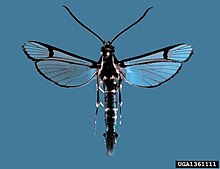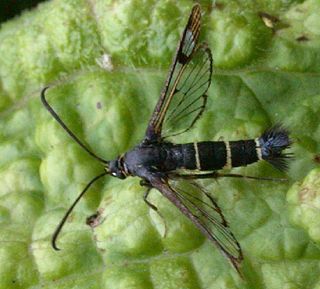
The Sesiidae or clearwing moths are a diurnal moth family in the order Lepidoptera known for their Batesian mimicry in both appearance and behaviour of various Hymenoptera.
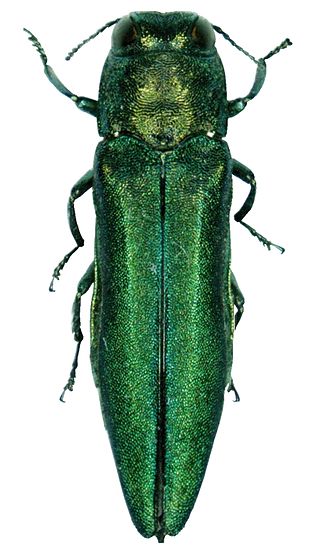
The emerald ash borer, also known by the acronym EAB, is a green buprestid or jewel beetle native to north-eastern Asia that feeds on ash species. Females lay eggs in bark crevices on ash trees, and larvae feed underneath the bark of ash trees to emerge as adults in one to two years. In its native range, it is typically found at low densities and does not cause significant damage to trees native to the area. Outside its native range, it is an invasive species and is highly destructive to ash trees native to Europe and North America. Before it was found in North America, very little was known about emerald ash borer in its native range; this has resulted in much of the research on its biology being focused in North America. Local governments in North America are attempting to control it by monitoring its spread, diversifying tree species, and through the use of insecticides and biological control.
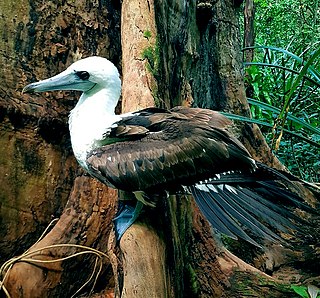
Abbott's booby is an endangered seabird of the sulid family, which includes gannets and boobies. It is a large booby and is placed within its own monotypic genus. It was first identified from a specimen collected by William Louis Abbott, who discovered it on Assumption Island in 1892.

Juniperus semiglobosa, the Himalayan pencil juniper, is a species of juniper native to the mountains of Central Asia, in northeastern Afghanistan, westernmost China (Xinjiang), northern Pakistan, southeastern Kazakhstan, Kyrgyzstan, western Nepal, northern India, Tajikistan, and Uzbekistan. It grows at altitudes of 1,550–4,420 metres.

Pel's fishing owl is a large species of owl in the family Strigidae, found in Africa. It lives near rivers and lakes, and feeds nocturnally on fish and frogs snatched from the surface of lakes and rivers. The species prefers slow-moving rivers with large, overhanging trees to roost in and forage from. It nests in hollows and the forks of large trees. Though as many as two eggs are laid, often only one chick is raised.

Blyth’s frogmouth is a species of bird in the family Podargidae. It was previously considered to be conspecific with the Javan frogmouth and Palawan frogmouth. The bird is a tropical species that ranges from India to Australia.

The hornet moth or hornet clearwing is a large moth native to Europe and the Middle East and has been introduced to North America. Its protective coloration is an example of Batesian mimicry, as its similarity to a hornet makes it unappealing to predators. The hornet moth has been linked to the large dieback of poplar trees across Europe because its larvae bore into the trunk of the tree before re-emerging as adults.

Operophtera fagata, the northern winter moth, is a moth of the family Geometridae. It is widespread through much of Europe.

Peridroma saucia, the pearly underwing or variegated cutworm, is a moth of the family Noctuidae. The species was first described by Jacob Hübner in 1808. It is found in North and South America, Europe, Asia and Africa. The variegated cutworm feeds on many plants, especially common fruits and vegetables. The moth undergoes two to four generations per year. The development of the moth slows in colder temperatures, indicative of its migratory nature. All stages of the life cycle have a developmental threshold for temperature. The moth is known to migrate to the northern regions during warmer months, returning to the southern regions when the climate becomes colder.
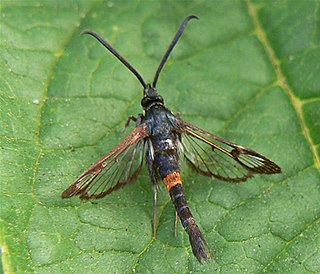
Synanthedon myopaeformis is a moth of the family Sesiidae and the order Lepidoptera. In Europe it is known as the red-belted clearwing and in North America as the apple clearwing moth. The larvae create galleries under the bark of fruit trees, especially old trees with damaged trunks. During this process, the larvae cause significant damage to host trees. Particular attention has been paid to the damage they cause to apple trees. Their status as a pest of apple orchards has led to many research projects aimed at controlling populations of the moth. This moth is native to Europe, the Near East and North Africa. Recently, the moth was introduced into North America, being first detected in Canada in 2005. There are several organisms that threaten the larvae, including parasitoids, nematodes, and bacteria.

Pseudosphinx is a monotypic moth genus in the family Sphingidae first described by Hermann Burmeister in 1856. Its only species, Pseudosphinx tetrio, was first described by Carl Linnaeus in 1771. Its common names include tetrio sphinx, giant gray sphinx, frangipani hornworm, and plumeria caterpillar. In the island of Martinique it is best known as Rasta caterpillar because of its colors which are reminiscent of the ones found in Rastafarian clothing and accessories. It is native to the tropical and subtropical Americas from the southern and southwestern United States to Brazil. The occasional individual has been recorded as far north as the northeastern United States.

Synanthedon scitula, the dogwood borer or pecan borer, is a moth that is a pest of many plants including the dogwood and pecan. It is notorious due to the severity of damage it can cause and its widespread geographical distribution.

Synanthedon pictipes, the lesser peachtree borer, is a moth of the family Sesiidae. It is known from the eastern half of Canada and the United States westward to Minnesota in the north and eastern Texas in the south.
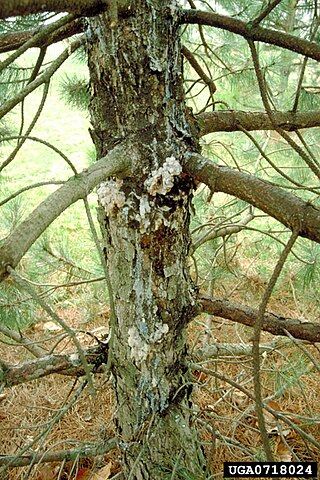
Synanthedon pini, the pitch mass borer, is a moth of the family Sesiidae. The pitch mass borer occurs on spruce and pine in eastern North America. It does not kill trees, but the pitch-filled larval tunnels in the wood cause defects in the lumber.

Synanthedon formicaeformis, the red-tipped clearwing, is a moth of the family Sesiidae and can be found in all of Europe, the eastern Palearctic realm, and the Near East. The larvae sometimes form pear-shaped galls on willows. It was first described by Eugenius Johann Christoph Esper in 1783.
Synanthedon flaviventris, the sallow clearwing, is a moth of the family Sesiidae. The larvae form pear-shaped galls on sallows.

Synanthedon scoliaeformis, the Welsh clearwing, is a moth of the family Sesiidae. It is found from almost all of Europe, east through Russia to Japan.

Hylastes ater is a species of beetle in the family Curculionidae, the true weevils. It is a bark beetle, a member of the subfamily Scolytinae. Its common name is the black pine bark beetle. It is native to Europe and parts of Asia, including China and Korea. It is known as an introduced species in many other regions, including Australia, New Zealand, the Americas, and South Africa. It is a pest of pines and other trees, and it is widespread in areas where pine trees are cultivated. The species "is an important threat to the biosecurity of all forested countries."

Agrilus biguttatus is a species of beetle in the family Buprestidae, the jewel beetles. Common names include oak splendour beetle, oak buprestid beetle, and two-spotted oak borer. It is native to Europe, North Africa, and Siberia. This beetle is known as a pest that causes damage to oak trees and is a factor in oak decline.
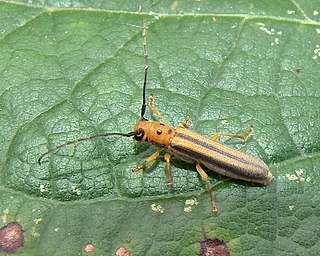
Oberea tripunctata, the dogwood twig borer, is a species of longhorn beetle that is a widespread pest that attacks dogwood trees.
